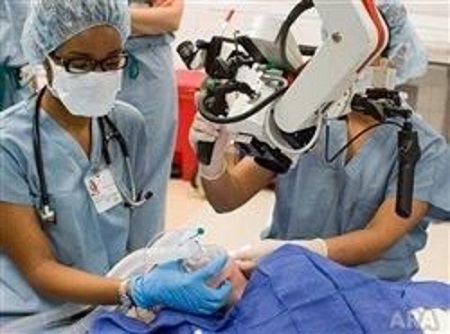Doctors at Wyckoff Heights Medical Center on the Ridgewood/Bushwick border recently performed an emergency surgery that helped a Brooklyn steel worker regain mobility in his legs and be able to walk again.
Parmanand Ramjas, a 31-year-old steel machine operator in Brooklyn, was recently at his job when he felt a sudden shooting pain across his shoulder and down his back. He then couldn’t move his legs at all.
Ramjas was rushed to Wyckoff Heights Medical Center where it was discovered that he had a large hematoma compressing his spinal cord, which was the cause of his paralysis.
“A hematoma is a collection of clotted blood that has pooled in tissue outside of blood vessels,” Jason Ellis, MD, a cerebrovascular neurosurgeon at Wyckoff Heights Medical Center and Northwell Health’s Lenox Hill Hospital in Manhattan, explained in a press release from Northwell Health. “Most often, hematomas are caused by injury to the walls of a blood vessel, which can result in blood seeping through the walls and accumulating in surrounding tissue.”
The source of Ramjas’ hematoma was not immediately known, Ellis added, noting that Ramjas didn’t suffer any trauma to the area or have any previous medical conditions that would make him susceptible to the spontaneous bleeding.
If there was any chance for Ramjas to walk again, doctors needed to take immediate action. So, they performed emergency surgery and successfully removed the blood clot and decompressed his spinal cord. Even after the surgery, there was no guarantee that Ramjas would ever be able to walk again.
During the surgery, Ellis found several bleeding blood vessels around Ramjas’ spinal cord, and discovered that the hematoma was from a rare spinal vascular malformation.
“Using precise and careful microsurgical techniques, I was able to quickly remove not only the blood clot that pancaked his spinal cord to a wafer-thin size, but also removed all of the delicate vessels that were part of the vascular malformation,” he said.
The complex surgery paid immediate dividends because soon after, Ramjas gained feeling and mobility below his waist and was able to move left foot, then his right foot. A few days later, he was able to walk again.
Following the surgery, Ramjas was transferred to Lenox Hill Hospital for a follow-up spinal angiogram — which is a minimally invasive procedure that offers a precise evaluation of the blood vessels surrounding the spinal cord — performed by Rafael Ortiz, MD, Lenox Hill’s chief of neuro-endovascular surgery and interventional neuroradiology.
“We were able to determine that there was no residual vascular malformation after surgery and Mr. Ramjas did not have any neurological deficits,” Ortiz said.
“I just broke down in tears,” Ramjas said. “Cherish every day. I never expected this to happen to me. I cannot be more thankful to Dr. Ellis and Dr. Ortiz.”




































